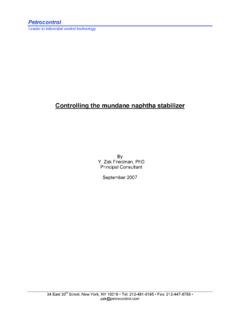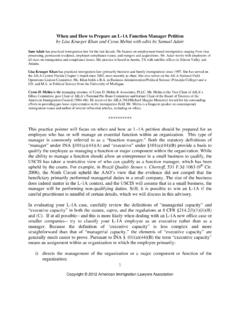Transcription of Critical Issues - Procurement Academy
1 MISSION STATEMENTCAPS Research contributes compet-itive advantage to organizations by delivering leading-edge researchglobally to support continuouschangeand breakthrough perform-ance improvement in strategicsourcing and RESEARCH IS JOINTLY SPON-SORED BY THE W. P. CAREY SCHOOL OF BUSINESS AT ARIZONA STATEUNIVERSITY AND THE INSTITUTE FORSUPPLY MANAGEMENT2 12 17 2329 SEPTEMBER 2003 Critical IssuesREPORTHot Topics in Today s Supply ChainManagementIntroductionCase One: Creating an IndirectPurchasing/SupplyOrganizationCas e Two: e- Procurement for Indirect SpendCase Three: Managing IndirectSpend ThroughActivity-BasedCostingCase Four:OutsourcingIndirect SpendEXECUTIVE OVERVIEW Indirect spend is receiving increased attention from the senior management of large corporations. This category of spend is the sum of all purchased goods and services that do not end up in products or services delivered tothe customer.
2 On average, indirect spend equals 50 percent of a company s , a significant amount of indirect spend is not purchased using the organization s purchasing/supply function or purchasing processes. Senior managementhas realized that reducing or eliminating indirect spend offers an opportunity to favorably affect a company s cost examples of indirect spend are: professional services, utilities, company travel, office products, and employee benefits. However, spend that is indirect for onecompany may be direct for another. Furthermore, segmenting direct and indirect spendcan be very difficult, particularly for service general, companies that are focusing on indirect spend are attempting to reduce it byimproving data collection, using electronic catalogs and purchasing automation systems,increasing the centralization of the purchasing organization, and implementing improvedprocesses and April 2003, CAPS Research, in partnership with Lucent Technologies, hosted an indirectspend workshop.
3 The intent of this workshop was to define, discuss, and develop thegood/best practices in the area of indirect spend. The workshop was centered on fourcase studies. Each presentation was followed by a group discussion of the case and thelessons Issues Report, September 2003: SPENDPHILLIP CARTEREXECUTIVE DIRECTOR, CAPS RESEARCHSTEWART BEALLDIRECTOR OF EXECUTIVE PROJECTS, CAPS RESEARCHCHRISTIAN ROSSETTIGRADUATE RESEARCH ASSOCIATE, CAPS RESEARCHERIC LEDUC GRADUATE RESEARCH ASSOCIATE, CAPS RESEARCHT hough each of the four case studies offered different methods for controlling indirectspend, they were complementary. The four cases can be summarized as: Organizing for indirect spend management Implementing systems to aggregate and leverage indirect spend Activity-based target costing for services Outsourcing the purchasing/supply function for non-strategic indirect spendBased on these presentations and the discussions that ensued, nine enabling tacticswere identified.
4 The tactics, used individually or collectively, can assist a company inmanaging and controlling its indirect spend. The nine tactics are:1. Zero-Based Budgeting2. Pre-Budget Savings3. Organizational Structure4. Accounts Payable Part of Purchasing/Supply5. Training Power Users6. Supplier Managed E-Catalogs7. Commodity Coding for Indirect Spend8. One Commodity Team for a Large Supplier9. Outsourcing Indirect SpendAs is true for most change management efforts, steadfast upper management supportis one of the most important aspects of managing and controlling indirect the past five years, purchasing/supply groups in well-managedcompanies have made great strides in reducing the price of inputs. Since specific direct materials are often associated with distinct Strategic Business Units (SBUs),managing this spend is usually accomplished through center-led commodity groups,with sourcing decisions and administration occurring at the SBU.
5 Though most companies are generally satisfied with the efforts they have made in strategicallysourcing their direct goods and services, most companies are still attempting to gaincomparable control and results with their indirect the purposes of this paper, indirect spend is defined as: Any purchased good orservice that does not end up in the product or service delivered to a examples of indirect spend include professional services, utilities, companytravel, office products, and employee increased outsourcing of non-core capabilities, the growth of the service sector, and increasing cost pressure, the importance of managing indirect spend is , due to the localized control of most indirect spend, the problem is more complexfrom a managerial and administrative standpoint. Issues often arise in segmenting indirectCritical IssuesREPORT2 Critical Issues Report, September 2003: the purposes of thispaper, indirect spend is defined as: Any pur-chased good or servicethat does not end up inthe product or servicedelivered to a customer.
6 Spend across or between different functional areas. Another common problem is that indi-rect spend may be hidden in the price of direct materials. For example, if a supplier pays forshipping, the transportation cost (indirect service) is buried in the cost of the direct address these problems, companies have started to look for methods to identify,manage, and reduce their indirect spend. These methods fall into one of two categories: internal and METHODSTo date, the most important internal measures have been collecting and consolidating data to facilitate leveraging, restructuring the purchasingorganization to establish indirect-spend accountability, automating the requisitioning/purchasing process, and standardizing what is collection and consolidation:Sometimes, several units within one organization often unknowingly purchase the same goods and services from different suppliers (or even the same supplier) at different prices.
7 In this situation, the corporation suffers due to loss of potential leveragewith indirect spend is to be leveraged, effective data collection and consolidation is management must have a clear understanding of what goods and servicesare being purchased by individual SBUs. Once the overall spend is recognized and analyzed, the company can then identify goods or services that might be channeledthrough one or two suppliers to achieve maximum leverage. Comprehensive data collection and analysis also allow companies to recognize similar, yet slightly different,goods or services that might be standardized and aggregated to aid in standardization and aggregation can result in a significant savings for a corporation. Therefore, developing data-gathering and analysis tools has been the foundation for many companies indirect spend management programs. Delta Airlines ( E-sourcing s Next Wave, InformationWeek,March 18, 2002) is one ofmany companies where data collection and analysis have been successful.
8 Previously,the company s hubs had acted, in many ways, like independent business units, contracting for their own services and supplies. Employees in each SBU throughout the corporation were making deals without letting any other SBU know what thosedeals were. Delta finally installed a software package that revealed many areas whereDelta could use its buying power to leverage discounts. Subsequently, Delta arrangedcontracts that saved the company millions. In just one three-month period, this contracting saved Delta $11 million on hotel rooms alone. Critical IssuesREPORT3 Critical Issues Report, September 2003: indirect spend is to beleveraged, effective datacollection and consoli-dation is Design Systems also recognized the need for good data. Cadence had an ERPsystem in place, but the system was unable to present the information in such a waythat purchasing could understand the nuances of the indirect spend.
9 Managementtherefore decided to install a software package that automated the information extrac-tion from the ERP into a separate analysis program. As a result, Cadence recognizedseveral opportunities for negotiating larger discounts and curtailing some of its maverickspend. One executive claimed that they achieved ROI in a matter of weeks and havealready saved millions of dollars through intelligence provided by this to establish accountability:Establishing supply management structure and setting up accountability for indirectpurchases are closely connected with data collection and consolidation. By gaining a clear understanding of who is spending what, where, and when, Procurement managers can install procedures and/or safeguards that deter and control maverickspend. At that point, the delegation of responsibility for cost saving is Critical . Such delegation includes setting up a chain of command that can respond with appropriateauthority when demanding that protocol be followed.
10 Case One details the design of a center-led indirect purchasing organization. With the flexibility to allow differentregions to make localized decisions, this structure appears to be a good fit with theindirect sourcing needs of most large Bayer Corporation ( Money Rooms Attack Bayer s Indirect Spend, Purchasing,November 1, 2001) provides another example of how a company can restructure itsprocesses and responsibilities to manage indirect spend in a non-centralized structure. Intackling its indirect spend concerns, Bayer initiated a program it called the Money Room. This program established money rooms in plants or administration units that act as control centers for the purchasing department. Indirect spend is typically mapped out into20 to 25 areas (columns) and are linked to days of the month (rows). Each day all requestsfor materials are sent to this room, where they are charted.






